Disclosing the Functional Potency of Three Oxygenated Monoterpenes in Combating Microbial Pathogenesis: From Targeting Virulence Factors to Chicken Meat Preservation
- PMID: 38540955
- PMCID: PMC10970324
- DOI: 10.3390/foods13060965
Disclosing the Functional Potency of Three Oxygenated Monoterpenes in Combating Microbial Pathogenesis: From Targeting Virulence Factors to Chicken Meat Preservation
Abstract
During the last few decades, there has existed an increased interest in and considerable consumer preference towards using natural and safe compounds derived from medicinal plants as alternatives to synthetic preservatives to combat microbial pathogenicity. In this regard, the present study investigated the possible synergistic interactions of the anti-foodborne bacterial capacity of linalool (L), eucalyptol (E), and camphor (C). The antibacterial synergistic effect was determined against Staphylococcus aureus, Listeria monocytogenes, Salmonella enterica Typhimurium, and Escherichia coli. The optimal predicted mixture showed the highest antibacterial activity at 33.5%, 33.2%, and 33.4% of L, E, and C, respectively. Molecular docking simulations displayed that the studied monoterpenes have effective antibacterial inhibitory effects by impeding specific virulence factors such as sortase A, listeriolysin O, L, D-Transpeptidase, and polyphosphate kinase. The selected triple combination of L, E, and C was applied as a natural preservative in minced chicken breast meat. In this regard, 1 MIC (16 µg/mL), 1.5 MIC (24 µg/mL), and 2 MIC (32 µg/mL) of L. monocytogenes were used, and the microbiological, physicochemical, and sensory analyses were monitored for 14 days of storage at 4 °C. The L/E/C mixture at different levels could delay lipid and protein oxidation, inhibit the microorganisms, and maintain the sensory attributes. Additionally, by using chemometric tools, strong connections between physicochemical properties, microbiological parameters, and organoleptic attributes were established. Concisely, this research confers the importance of the use of blended monoterpenes and highlights their antibacterial mode of action, effectiveness, and synergistic effects as a powerful and safe bio-preservative formulation in chicken meat products.
Keywords: bio-preservation; chemometric analysis; mixture design; molecular docking; oxygenated monoterpenes; virulence factors.
Conflict of interest statement
The authors declare no conflict of interest.
Figures
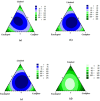

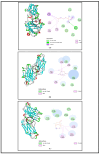
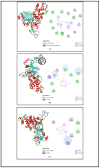
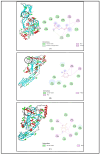

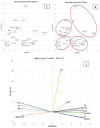
Similar articles
-
A New Approach in Meat Bio-Preservation through the Incorporation of a Heteropolysaccharide Isolated from Lobularia maritima L.Foods. 2022 Dec 6;11(23):3935. doi: 10.3390/foods11233935. Foods. 2022. PMID: 36496743 Free PMC article.
-
A Combination of Linalool, Vitamin C, and Copper Synergistically Triggers Reactive Oxygen Species and DNA Damage and Inhibits Salmonella enterica subsp. enterica Serovar Typhi and Vibrio fluvialis.Appl Environ Microbiol. 2019 Feb 6;85(4):e02487-18. doi: 10.1128/AEM.02487-18. Print 2019 Feb 15. Appl Environ Microbiol. 2019. PMID: 30552187 Free PMC article.
-
Antimicrobial and antioxidant activities of hydrocarbon and oxygenated monoterpenes against some foodborne pathogens through in vitro and in silico studies.Pestic Biochem Physiol. 2019 Jul;158:185-200. doi: 10.1016/j.pestbp.2019.05.008. Epub 2019 May 16. Pestic Biochem Physiol. 2019. PMID: 31378356
-
Citrus lemon essential oil: chemical composition, antioxidant and antimicrobial activities with its preservative effect against Listeria monocytogenes inoculated in minced beef meat.Lipids Health Dis. 2017 Aug 3;16(1):146. doi: 10.1186/s12944-017-0487-5. Lipids Health Dis. 2017. PMID: 28774297 Free PMC article.
-
Facile synthesis and characterizations of antibacterial and antioxidant of chitosan monoterpene nanoparticles and their applications in preserving minced meat.Int J Biol Macromol. 2020 Aug 1;156:127-136. doi: 10.1016/j.ijbiomac.2020.04.044. Epub 2020 Apr 11. Int J Biol Macromol. 2020. PMID: 32289415
Cited by
-
Therapeutic efficacy of LysGH15 against necrotising pneumonia caused by Staphylococcus aureus in a rabbit model.Front Vet Sci. 2025 Feb 10;12:1529870. doi: 10.3389/fvets.2025.1529870. eCollection 2025. Front Vet Sci. 2025. PMID: 39981314 Free PMC article.
-
Betalains from Opuntia stricta peels: UPLC-MS/MS metabolites profiling, computational investigation, and potential applicability as a raw meat colorant.Heliyon. 2024 Oct 24;10(21):e39784. doi: 10.1016/j.heliyon.2024.e39784. eCollection 2024 Nov 15. Heliyon. 2024. PMID: 39524753 Free PMC article.
References
-
- Özlü H., Çevik B., Atasever M., Sarialioğlu M., Polat B. Investigation of meat species adulteration in beef-based meat products via real-time PCR in Türkiye. Qual. Assur. Saf. Crop. Foods. 2023;15:42–48. doi: 10.15586/qas.v15i4.1374. - DOI
-
- Pellissery A.J., Vinayamohan P.G., Amalaradjou M.A.R.K., Venkitanarayana K. Chapter 17-Spoilage bacteria and meat quality. In: Biswas A.K., Mandal P.K., editors. Meat Quality Analysis. Academic Press; Cambridge, MA, USA: 2020. pp. 307–334. - DOI
-
- Filipčev B. Chapter 16-The effects of aromatic plants and their extracts in food products. In: Florou-Paneri P., Christaki E., Giannenas I., editors. Feed Additives. Academic Press; Cambridge, MA, USA: 2020. pp. 279–294. - DOI
LinkOut - more resources
Full Text Sources
Molecular Biology Databases

